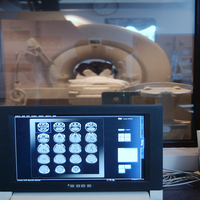A New Treatment for Toxoplasmosis

I have talked at some length about the possible link between toxoplasmosis and some forms of mental illness, but there is also another side to toxoplasmosis: the Toxoplasma gondii parasite infects nearly one-third of all humans: more than two billion people worldwide. In the United States alone, congenital toxoplasmosis occurs in an estimated 1 per 5,000 births a year and can cause severe vision loss, brain damage and even death. The human cost is incalculable, and in dollars and cents, it has been estimated that the annual cost of caring for these children may exceed $1 billion.
Toxoplasma gondii is carried by some cats and it is said that an infected cat can excrete up to 20 million oocysts over a period of two weeks, and every single oocyst is infectious. They are tenacious and can remain infectious in water for up to six months and in warm moist soil for a year of more.
Toxoplasma infects humans through three main routes:
- Consumption of undercooked, infected meat
- Ingestion of T. gondii oocysts in food, through accidental contamination from cat litter
- Finally, a newly infected pregnant woman may pass the infection to her fetus, hence the warning that pregnant women should not clean the cat box
Not only is toxoplasmosis the most common parasitic infection in the world, but also it can cause particular problems in people with compromised immune systems, for instance people with cancer, autoimmune disease, AIDS or transplant recipients.
It is even possible for people with normal immune systems to suffer major organ damage from chronic infections. Eye disease leading to loss of sight can be caused both a primary infection and as a result of infection transmitted from mother to child. Damage to other organs has recently caused deaths among otherwise healthy young people during epidemics in Surinam and French Guiana.
The parasites that cause malaria are related to Toxoplasma gondii, and a new drug that will soon enter clinical trials for the treatment of malaria also appears to be 10 times more effective than the current gold-standard treatment of toxoplasmosis, a combination of the drugs pyrimethamine and sulfadiazine.
In the March issue of PLoS Neglected Tropical Diseases, a research team based at the University of Chicago Medical Center reports that the drug, known as JPC-2056, is extremely effective against Toxoplasma gondii, both in cell culture and in mice, and apparently without the toxicity associated with the current standard treatment.
The drug works inhibiting the action of the from of the enzyme dihydrofolate reductase (DHFR) that is produced by the family of parasites that includes those that cause toxoplasmosis and malaria, and in cell culture studies, the drug appears actually to kill the parasite, rather than simply preventing its replication. This is very important: not only do most of the current medications have a good many side effects, they have little effect on Toxoplasma during certain phases of its life cycle. It can hunker down in the quiescent cystic phase and wait until the antibiotics are gone.
Rima McLeod, professor of ophthalmology and specialist in infectious diseases at the University of Chicago said,
“JPC-2056 has the potential to replace the standard treatment of pyrimethamine and sulfadiazine. Taken by mouth, is easily absorbed, bioavailable, and relatively nontoxic. In tissue culture and in mice, it was rapidly effective, markedly reducing numbers of parasites within just a few days.”
JPC-2056 is not a new drug. It was developed in the late 1980s by teams led by Wilbur Milhous and Dennis Kyle of the Walter Reed Army Institute for Research and David Jacobus of Jacobus Pharmaceutical Company. The original version was quite toxic, but the researchers found ways to reduce the toxicity and developed an oral version of the drug. Clinical trials using JPC-2056 to treat malaria are scheduled to begin later this year.
A New Lie Detector?

I am sure that this is a story that is going to be picked up and re-worked by those excellent writers over at Law and Order.
An academic at the University of Sheffield has used groundbreaking technology to investigate the potential innocence of a woman convicted of poisoning a child in her care.
Professor Sean Spence, who is a pioneer in the use of functional Magnetic Resonance Imaging (fMRI) to detect lies, carried out the experiments on the woman who, despite protesting her innocence, was sentenced to four years in prison. His results have now been published for the first time in the journal European Psychiatry.
Sean examined the woman’s brain activity as she alternately confirmed her account of events and that of her accusers. The tests demonstrated that when she agreed with her accusers´ account of events she activated extensive regions of her frontal lobes and also took significantly longer to respond: these findings have previously been found to be consistent with false or untrue statements.
Although the technology has previously been claimed to be 90% accurate, which is far superior to “lie detector” – polygraph – tests, its use has also been open to debate. Lie detection tests are already used regularly in parts of the United States justice system, as well as by businesses. But as far as I know, these are the first brain scanning tests of their kind, carried out on a real-life case, reported in the world literature.
Professor Spence said:
“This research provides a fresh opportunity for the British legal system as it has the potential to reduce the number of miscarriages of justice. However, it is important to note that, at the moment, this research doesn’t prove that this woman is innocent. Instead, what it clearly demonstrates is that her brain responds as if she were innocent.”
“If proved to be accurate, and these findings replicated, this technology could be used alongside other factors to address questions of guilt versus innocence.”
Decision Making and Internal Balance

Many of us run into problems when we try to make decisions. In a special section in the October 26 issue of the journal Science, Martin Paulus who is a professor in the Department of Psychiatry at the University of California in San Diego, has marshaled a growing body of evidence that human decision-making is inextricably linked to an individuals’ need to maintain a homeostatic balance.
He goes on to suggest that psychiatrists may need to approach the treatment of psychiatric patients from a new direction: by understanding that such individuals’ behavior and decision-making are based on an attempt to reach an inner equilibrium, in the same way that we try to being our temperature or blood pressure back to a set point. And if the thermostat is broken we may see mental illness and substance abuse.
This makes good sense: in the past decision-making process as a considered series of options and values, but that is not what we see in the clinic. People with addictions and some mental illnesses keep making bad choices, despite being intelligent and insightful.
Recent neuroimaging research shows strong support for the homeostatic nature of decision-making:
The insula is involved in processing interoceptive information: the body’s internal state or sense of balance
Damage to the insula stops addiction to cigarettes
Some of the same brain structures implicated in the urge to take drugs are involved in other biological urges
The question addressed in part by this paper are whether changes in decision-making behavior and associated brain functions are a result of pre-existing characteristics – which may predispose individuals to use drugs – or occur as a consequence of long-term use.
This is certainly an interesting idea, and we shall have to see how it fits as we collect further data.
“The quality of a decision is like the well-timed swoop of a falcon which enables it to strike and destroy its victim.”
–Sun Tzu (Chinese Military Strategist and Author of the “Art of War”, c.400-c.430 B.C.E.)
“The risk of a wrong decision is preferable to the terror of indecision.”
–Maimonides (a.k.a. Rabbi Moses ben Maimon, Spanish-born Jewish Philosopher and Physician, 1135-1204)
“All you have to decide is what to do with the time that is given you.”
–J.R.R. Tolkien (South African-born English Writer, Linguist, Oxford Don and a Member of C.S. Lewis’ Literary Group, “The Inklings,” 1892-1973)
“Decisions are doorway to change and change starts from a moment of decision. One decision can change your life forever!”
–Tony Robbins (American Motivational Speaker and Writer, 1960-)
“Nothing is more difficult, and therefore more precious, than to be able to decide.”
–Napoleon Bonaparte (Corsican-born French Military Strategist, General and, from 1804-1814, Emperor of the French, 1769-1821)
Rhythms in the Brain

It is often a bit frustrating to read articles about the brain in which the writer says things like: “research has shown that the insula does this…” or “the amygdala does that…”
This idea that it is possible to reduce brain functions to regions of the brain is not correct. Some years ago I used the term “Neo-phrenology,” to describe this fallacy, though I am sure that I was not the first. (Phrenology was the old and discredited theory that you tell things about people by examining the bumps on their heads.)
So why is it a fallacy? The idea that certain functions can be “localized” to a bit of the brain is called “naïve localizationism.” The vast majority of the psychological functions of the brain are performed by distributed networks, not a single lump of tissue. One of the remarkable things about the human brain is that it can recruit new circuits as they are need. If we do not have enough brainpower to solve a problem, other systems are taken off line so that they do not distract and may be able to help. You have probably had the experience of working on something so intensely that you lose track of time, and fail to hear things going on around you.
Yes, there are regions that have jobs to do. For instance the auditory cortex is responsible for processing sound. But after that initial processing the rest of the brain becomes involved in deciding what to do with the information. The key to understanding the brain is how different regions of the brain communicate. As I recently mentioned in a different context, there are good reasons for believing that a number of problems, from the schizophrenias to the attention deficit disorders, may all be a result of poor communication between different regions of the brain.
Part of the problem is working out how regions communicate has been technical: we have not had the computers or hardware to do the measurements. But that is beginning to change.
Earl Miller, a professor of neuroscience at Massachusetts Institute of Technology’s Picower Institute for Learning and Memory, recently said that today’s faster computers and more advanced electronics might provide scientists with the tools they need to unlock the brain’s mysteries.
“Multiple electrode recording techniques, offer a whole new level of brain interactions that can’t be seen using the [current] piecemeal approach.”
Two studies published recently in th journal Science support this idea.
In the first Thilo Womelsdorf and a group of neuroscientists at the F. C. Donders Center for Cognitive Neuroimaging at Radboud University Nijmegen in the Netherlands, looked at the electrical activities of groups of neurons in the brains of cats and monkeys wile they were engaged in an array of different tasks. They found that two groups of neurons could only communicate efficiently with each other when their rhythms are coordinated, or synchronized. If the rhythms are not coordinated, then one group sends information while the other is not ready to take it on and vice versa.
The researchers found that when the rhythms of electrical activity are synchronized between neurons in distinct brain areas, memories are made and tasks are completed more efficiently.
The other study, by scientists at the University of Melbourne in Australia, also revealed communication between the cerebral cortex and the deep medial temporal region.
They flashed two images at a group of macaque monkeys for less than a second. The monkeys had to decide whether the spatial orientation of a stack of bars in two images were the same or different. While the animals worked, researchers monitored the electrical fields in the posterior parietal cortex, which is one part of the system involved in directing spatial attention. At the same time they looked at the medial temporal area, a region deep in the midbrain that handles movement perception. The researchers had hypothesized that these two areas need to communicate with one another to enable reasoning.
The researchers observed activity first in the parietal cortex, followed by synchronous action there and in the medial temporal area. The delay illustrates “a top-down” feedback from the cortex, which then signals the lower area.
One of the authors, Trichur Vidyasagar, said,
“The parietal neurons seem to code for what is salient or relevant in the world and allocate attentional resources accordingly. The medial temporal neurons are sensory ones that process the visual signals, but due to the influence of the parietal cortex the activity across the medial temporal area is varied.”
The studies were accompanied by an editorial in which Robert Knight, a cognitive neuroscientist at the University of California, Berkeley, praised the findings – and their potential significance.
This research is important for two reasons:
First it confirms that the key to understanding the brain is the interaction of networks.
Second, there are a number of periodic disorders, such as depression, seasonal affective disorder, mania and even some rare types of episodic psychosis that are episodic and are not associated with any clearly defined neuroanatomical disruption. It may well be that some of the periodic symptoms are caused by intermittent network dysfunction, as a result of disturbed oscillatory dynamics.
“In all things there is a law of cycles.”
–Publius Cornelius Tacitus (Roman Historian, Writer, Orator and Public Official, A.D.56-c.120)
“Human beings, vegetables or cosmic dust, we all dance to the same mysterious tune, intoned in the distance by an invisible player.”
–Albert Einstein (German-born American Physicist and, in 1921, Winner of the Nobel Prize in Physics, 1879-1955)
“It has been said that a complete understanding of the Law of Cycles would bring man to a high degree of initiation. This Law of Periodicity underlies all the processes of nature and its study would lead a man out of the world of objective effects into that of subjective causes.”
–Alice A. Bailey (English Writer, Spiritual Teacher and Founder of the Arcane School, 1880-1949)
“At the heart of each of us, whatever our imperfections, there exists a silent pulse of perfect rhythm, a complex of wave forms and resonances, which is absolutely individual and unique, and yet connects us to everything in the universe. The act of getting in touch with this pulse can transform our personal experience and in some way alter the world around us.”
–George Leonard (American Aikidoist and Writer, 1923-)
Solar Cycles and Human Disease

We have all heard about the supposed association between full moon and mental illness, though most of the research has failed to find an association between phases of the moon and mood disorders or psychosis.
But something that we have not heard so much about is the possible association between solar activity and human problems.
Investigators from Chile presented some interesting data (NR308) at the 2007 Annual Meeting of the American Psychiatric Association in San Diego last month.
They used a measure of solar activity called the Wolf number that is based on the number of sunspots. The sunspot cycles are usually between 9.5 and 11 years. They examined the clinical records of 1862 individuals who had been seen at a psychiatric clinic in Santiago over a sixteen-year period, which corresponded to one and a half solar cycles. They found that there was a big rise in admission for severe depression during years with low solar activity and a slight increase in the number of admission for mania during years of high solar activity.
This is not the first time that a connection has been found between the sun and human affairs.
The same authors published a paper in Spanish two years ago in which they also found that depression is more common when there is less solar activity and mania increases when there is more activity. They cannot say whether it is just light that is causing this or some other form of radiation.
Two researchers used the Maine Medicaid database to look at the relationship between solar cycles and human disease, and found that that radiation peaks in solar cycles and particularly in chaotic solar cycles (CSCs) are associated with a higher incidence of mental disorders. The same researchers had previously used the same database to suggest that CSCs produce more ultraviolet radiation and it is this that limits human longevity by causing chromosomal damage.
Interestingly, in 1993 two researchers also suggested a relationship between solar activity and longevity. They looked at the mean longevity of birth cohorts from 1740 to 1900 for United States of America (U.S.) Congressional Representatives exhibited oscillations that coincided with the 9- to 12-year sunspot cycle. They found that the mean longevities of these cohorts were 2-3 years longer during times of low sunspot activity than at peak activity. This phenomenon was confirmed in data from members of the House of Commons of the United Kingdom Parliament and from University of Cambridge alumni.
Researchers in Slovakia have suggested that there may be an association between solar radiation and cerebral strokes, though their data is a little difficult to interpret.
It is clear that the Heavens have more of an impact upon us than many scientists realized, and need to be factored into studies of human mood and behavior.
Larks, Owls and Depression

It is well known that mood disorders are associated with the disruption of many of the circadian rhythms of the body including sleep, temperature and thyroid function. These links are so well known that many experts believe that depression may be a consequence of disturbances in circadian rhythms.
Although circadian rhythms tend to be fairly consistent across individuals, but there are significant differences in these rhythms in different people: we call this the “morningness-eveningness” dimension (MED).
As part of a larger project, researchers from Providence, Rhode Island last month presented a most interesting study (NR293) at the 2007 Annual Meeting of the American Psychiatric Association in San Diego.
People with psychiatric problems tend to be owls: evening types who don’t like mornings, and this was particularly striking in people with depression.
This suggests that “eveningness” may be reflecting a risk factor or vulnerability to psychopathology, in particular depression. It may actually be that if you are a “morning person,” you may have some protection against developing depression.
I remember seeing a study from Stanford in April that suggested that people labeled a “night owls” report more pathological symptoms related to insomnia, despite many having the opportunity to compensate for their nocturnal sleeplessness by extending their time in bed and being able to gain more total sleep time. So this may be the link with depression.
Does Anakin Skywalker Have Borderline Personality Disorder?

It is often very helpful to use books and movies to illustrate psychological and psychiatric issues, and that old chestnut, “when is it an illness?”
There was an amusing paper (NR193) about a serious problem that was presented last week at the 2007 Annual Meeting of the American Psychiatric Association in San Diego. The writers, from Toulouse in France entitled their offering; “Is Anakin Skywalker Suffering from Borderline Personality Disorder?”
Borderline personality disorder can be an extremely difficult problem to treat in practice, and it often causes a great deal of suffering. There is an interesting sidebar here: Borderline Personality Disorder has been described throughout the world. But it seems to be more common in the United States and Canada than it is in Western Europe, though the rates now appear to be rising in Europe.
Borderline personality disorder is defined as a mental illness primarily characterized by emotional dysregulation, extreme “black and white” thinking, or “splitting“, and chaotic relationships. It typically includes a pervasive instability in (1) mood, (2) interpersonal relationships, (3) self-image, (4) identity, and (5) behavior, as well as a disturbance in the individual’s sense of self. In extreme cases, this disturbance in the sense of self can lead to periods of dissociation.
These problems can have a pervasive negative impact on many or
all of the psychosocial aspects of life, including employability and
relationships in work, home, and social settings. Comorbidity
is very common. People with borderline personality disorder frequently have
substance use disorders and affective disorders. Sadly, self-harm , including cutting and suicidality and
completed suicide are altogether too common, and there is a lot of discussion about the effectivess of treatment.
The writers of the report concluded that Anakin met five criteria of Borderline Personality Disorder:
- Difficulty controlling anger
- Impulsivity
- Transient stress-related paranoid ideas and sever dissociative symptoms (after killing the sand people and in the final confrontation at the end of Episode 3)
- Frantic efforts to avoid real or imagined abandonment (as when trying to save his wife)
- Pattern of intense and unstable interpersonal relationships, alternating between extremes of idealization and devaluation (as in his relationships with the Jedi Masters)
They also suggested that the identity disturbance, when he changed into Darth Vader was more evidence of Borderline Personality Disorder.
An amusing piece, but it helps to highlight a problem that can cause great suffering.
Musical Hallucinations

A paper on auditory hallucinations of music was presented
this afternoon at the 2007 Annual Meeting of the American Psychiatric
Association in San Diego, California.
The researcher looked at 22 people diagnosed with schizophrenia and
23 with schizoaffective disorder at Maimonides Medical Center in
Brooklyn, New York. The question was whether it would be possible to
use the presence of musical hallucinations to distinguish between
schizophrenia and schizoaffective disorder. The conclusions from the
study were that these auditory hallucinations of music were more common
in people with schizoaffective disorder and that voices with a
religious or superstitious content were more common in people with
schizophrenia.
Though it is good to see someone examine the content of hallucinations, this was a very puzzling study.
First, there is always a lot of debate around the “schizoaffective”
diagnosis. Although there are clear criteria for it in the DSM-IV, many
experts believe that most people who have been labeled
“schizoaffective” actually have a form of bipolar disorder. But in any
case, bipolar disorder and schizophrenia probably lie on a spectrum.
People’s diagnoses often change over time. Not because of disagreement
or inaccuracy, but because people change over time. The term
“phenomenological drift” has been used to describe this observation.
What that means is that we always need to be sure of the diagnosis at
the time of the study, rather than what was written in the chart in the dim and distant past.
The other point is that genuine musical hallucinations are very
rare. The world literature contains under a hundred papers in European
languages, and the classic paper,
published by German Berrios in 1991 was an analysis of just 46 cases.
Berrios is regarded by many as one of the finest phenomenologists in
Europe, so it is surprising that the investigator in New York found so
many cases.
It will be good to see if the author or someone else can replicate
the work. The classic teaching about musical hallucinations has been
that they:
- Are more common in women
- Are more common in people who have hearing problems or are deaf
- Are more likely to occur in people with neurological diseases, including Alzheimer’s disease
- If they occur in people with neurological disease, it is more
likely that the damage will be in the right or non-dominant hemisphere
of the brain. (In men, language tends to be in the dominant hemispheres
and music in the non-dominant. The pattern is a bit more complicated in
women, but they also usually sing and recognize music with the right or
non-dominant hemisphere)
A recent report from Japan reported that an elderly man with musical hallucinations was helped with the cholinesterase inhibitor donepezil (Aricept), suggesting that cholinergic neurons are somehow involved in generating musical hallucinations.
Many of us have music or tunes giong round in our heads, but that is quite different from hallucinating music.
And let me repeat: hearing things is common, and does not mean that someone is mentally ill.
House Supporting NAMI
Regular readers will know two things about me:
- I am a huge advocate for the mentally ill
- Last year I had to publish two denials after some mendacious individual posted the preposterous suggestion that the character of Gregory House in the wonderful TV show, was in some way based on me. To this day I don’t know where that idea came from, other than the fact that I have specialized in trying to crack diagnostic conundrums.
Take the two together, and I’d like to give credit where it’s due.
I was delighted to see that the entire cast and crew got together to support the National Alliance of the Mentally Ill (NAMI).
House has a well known expression, "Everyone lies." The the show’s producers and cast members, along with the slogan, will benefit the organization and its work in education, support, and advocacy for individuals and families affected by mental illness.
For a limited time, T-shirts from the show, emblazoned with the phrase "Everybody Lies," are being sold on-line.
The executive producer of house is Katie Jacobs, and she had this to say:
"Mental illness is stigmatized and misunderstood in our society, and we’re trying to do something about that. We’re very fortunate to be celebrating an extremely successful third season for HOUSE, and we’d like to give something back to a cause we feel is both worthy and overlooked."
The TV show, in the course of showing Dr. House attempting to diagnose illnesses with hallucinatory or psychotic symptoms, has helped educate the public about the medical nature of many psychiatric symptoms including mood and personality changes. These diagnoses have included herpes encephalitis, syphilis, hypercortisolism (Cushing’s), Wilson’s disease, hemochromatosis, and Korsakoff’s syndrome (vitamin B1 deficiency).
"Everybody Lies" conveys a message about stigma, false perceptions and misinformation about mental illness. In the TV show, the phrase represents that people who are being diagnosed with ANY illness often withhold information. In a time when it seems that Hollywood has been indifferent to, or even has propagated, stigma about mental illness, it is refreshing that the producers and cast of a TV show are helping to combat that.
NAMI executive director Mike Fitzpatrick says,
"On behalf of every individual and family who live with major depression, bipolar disorder, schizophrenia and other mental illnesses, NAMI thanks the show and cast. They are making a difference in people’s lives."
In addition to the sale of the T-shirts, an on-line auction is running for seven days (1 May 2007 through 7 May 2007) to sell five special autographed items. All proceeds go to NAMI.
Marijuana and Psychosis

A number of my friends and colleagues in London have shown how cannabis (marijuana) may trigger a psychotic illness. A team at the Institute of Psychiatry gave healthy volunteers the active ingredient tetrahydrocannabinol (THC).
They then recorded reduced activity in an area of the brain called the inferior frontal cortex that keeps inappropriate thoughts and behaviors in check. The inferior frontal cortex is part of the self-regulatory systems of the brain that stop us swearing inappropriately, and help us to realize that people are not looking at or spying on us. In other words the inferior frontal cortex checks the environment and stops us jumping to conclusions that could lead to paranoia.
The THC was given to healthy volunteers who had not abused marijuana. The effects were short-lived, but more sever in some people than others, suggesting a genetic vulnerability.
In another study from Yale University, THC was given intravenously. Even at fairly low doses, 50% of healthy volunteers began to show symptoms of psychosis. As expected, people who had a previous history of psychosis were particularly vulnerable to the effects of THC.
A separate study has shown that one of these ingredients – cannabidiol (CBD) – has the potential to dampen down psychotic symptoms, and could perhaps form the basis of new treatments.
Whenever people start talking about the possible association between psychiatric problems and using marijuana, there are always loads of people who protest, “But I’ve used it for years and it’s never done me any harm.”
They may be right, but that objection misses four important points:
- People vary in their sensitivity to marijuana. Mental illness is the result of both genes and environment. Somebody who is very stressed but has no known genetic predisposition may run into trouble, while somebody with strong genetic loading and a minimal amount of stress can get very ill very quickly. And that stress can be anything from marijuana to abuse. There is also a lot of variation in how people respond to specific types of stressors
- If people have already had some psychological trouble, marijuana can be like pouring gasoline on a fire
- The age at which marijuana is used is all important. There seem to be “critical periods” in brain development, when marijuana can be particularly risky. There is a strong correlation between the number of times someone uses it under the age of eighteen and their subsequent risk of developing psychosis later in life. This relationship does not seem to hold with regular cigarettes, alcohol or any of the other street drugs looked at so far, suggesting that this is not just a matter of young people who are self-medicating. We cannot prove “causality” any more than we can “prove” that cigarette smoking causes lung cancer. Trying to prove a single cause for an illness is a tricky business. There are some examples, for instance illnesses caused by a single gene, but they are few and far between
- The marijuana available today is very different from the anemic material that was available in the 1960s and 1970s. Today’s is far powerful
This research provides the strongest evidence yet that modern marijuana can have a significant impact on the brain. Proving a long-term effect would be extremely difficult: it would be neither ethical nor feasible to stimulate long-term psychosis in volunteers.
But clearly if something has an active effect in inducing the symptoms of psychosis after one dose, it would not be at all surprising if repeated use could induce a chronic problem, particularly if someone is genetically predisposed.






